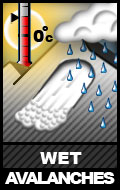Saturday:
Click here to see the complete danger scale
An ongoing temperature inversion (or at least anomalous temperature profile), which seems to have allowed for a substantial overnight freeze at the lower elevations, has prevented such a hard re-freeze of wet snow at the mid to upper elevations (above 2500′). This lack of an overnight freeze, combined with light winds (which aren’t expected to have much of a cooling effect) and plenty of sun today, are all expected to contribute to an ongoing wet avalanche problem.
Concerns:
Click here to learn more about loose wet avalanches
Click here to learn more about wet slab avalanches
Expect this concern to be most problematic in steep, upper elevation (above 3500′), sun-exposed terrain. Turns may initiate large “rollerballs” and wet sluffs that gain mass and momentum as they descend. While slow moving, the snow entrained is heavy and wet-concrete-like. It can pack quite the punch if one is unfortunate enough to be in the way. While such avalanches are expected to only be D1-1.5 in size today (click here to see destructive force scale), the consequences will be greatly exacerbated by terrain choices (terrain traps and exposure).
In thin, rocky areas of the snowpack, with sufficiently steep terrain, small natural wet avalanches (primarily loose) may be possible as well.
Click here to learn more about this type of problem and how to manage it
Cornices that grew in size from strong winds earlier in the week, before the meltdown, have been significantly weakened and destabilized by warm above freezing temperatures. In the South Fork Eagle River area Thursday, many small cornice failures were evident some of which triggered subsequent avalanches (wind slabs early in the week and wet loose later in the week).
Cornices may pose a danger today by breaking from below if you’re on top of them (human triggered) as well as failing and falling from above (naturally triggered) if you’re below them and possibly creating a subsequent avalanche. Be mindful of your exposure to them from above, below, and any runout from an avalanche a cornice failure could trigger.
Click here to learn more about this type of problem and how to manage it
The persistent slab problem is very unlikely and expected to only be an issue deeper and higher in the mountains on the periphery of the advisory zone. Where drier snow remains, the old melt-freeze crust from the January warmup has some faceting around it and was found up to 5000′ last weekend in the Eagle River area; it seems like it may have been responsible for a noteworthy natural avalanche cycle on steep northerly terrain after the appreciable deposit of new snow we received middle of last week.
Near or above freezing temperatures, without having created a specifically wet avalanche problem, may contribute to increased reactivity of such persistent instabilities. While there are no recent snow or weather observations (since last Sunday) available for the areas and terrain where a lingering persistent slab problem is a possibility, recent weather is expected to be playing some role in destabilizing the snowpack in these areas via increased likelihood of dry or wet avalanches.
Mountain Weather:
Partly cloudy with light winds and alpine temperatures in the upper 20s to lower 40s.



